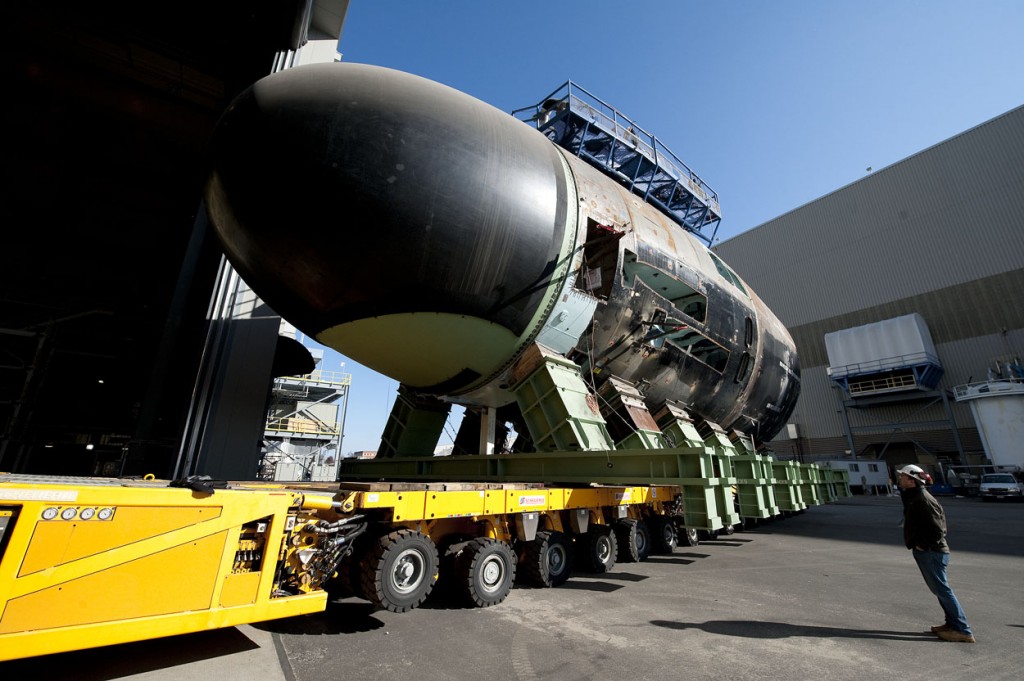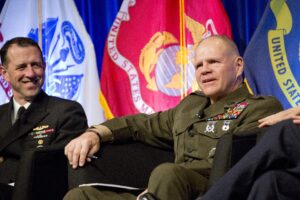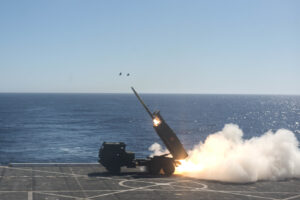
The USS Warner under construction in Newport News, one of the last two shipyards in the US able to build a nuclear-powered submarine.
SAN DIEGO: Why does the Marine Corps Commandant want the Navy to build more attack boats? “As a naval force, part of a maritime campaign, we need more attack submarines,” Gen. Robert Neller said at the AFCEA-USNI WEST conference.

Commandant Robert Neller (right) and Chief of Naval Operations John Richardson together at a previous WEST conference.
Why? “I want to get where I’m going,” Neller said to laughter from the audience. “A bunch of lance corporals with M4s on the flight deck are not going to help me out.” In other words, if the amphibious warships carrying the Marines are to make it to striking distance of a hostile shore without being sunk, they need an escort of Navy submarines and aircraft — and (though Neller didn’t mention this last one) probably also Aegis ships for anti-aircraft and missile defense.
“When was the last time we had to fight to get to the fight? We just went,” Neller mused. Today, though, “we’re going to have to fight to get there.”
Long-range precision-guided missiles, once a US monopoly, have proliferated to states like China, Russia, North Korea and Iran, along with the sensors to find targets for them and the networks to control them. Such layered defenses — known as Anti-Access/Area Denial (A2/AD) — are designed to keep US air- and seapower from getting close enough to strike, let alone close enough for Marines to hit the beach.
“We operate every day in an A2/AD environment, it’s just not turned on,” Neller said. “When it gets turned on, are we going to be able to survive?”

Chinese weapons ranges (CSBA graphic)
Of course, even in peacetime, the A2/AD system’s sensors will be watching, its command and control networks will be collecting data — it’s only the weapons that are “not turned on.”
The Navy’s Pacific Fleet has been “the most aggressive” organization in thinking through how to cross contested waters, Neller said: “You’re not just out there sailing across the open ocean, you’ve got to be aware that you’re being surveilled, you could be targeted.” Naval, air, and land forces all need to reduce their electromagnetic signature, which means being mindful of how they use the radars, radios, and wireless networks that become ubiquitous. Troops must transmit briefly or not at all. The idea is “not to go back to the stone age of messengers and flags and whistles and cymbals and trumpets, but those are hard to jam,” Neller said to laughter.
Marines have been training more for “force on force” engagements with nation-state adversaries after 17 years of counterinsurgency, Neller and other Marine officials have said. That requires reviving old skills such as fighting in full chemical/biological protective gear (MOPP-4), digging in against enemy air raids — something the US military hasn’t experienced since 1953 — and moving artillery batteries after they fire before the enemy can find them and retaliate (“shoot and scoot”). It also requires developing new capabilities such as a large drone (designated MUX) that can launch from Marine amphibious ships to do long-range reconnaissance and anti-ship missiles for Marine HIMARS launchers so they can help kill the enemy fleet.

A Marine HIMARS missile launcher fires from the deck of the USS Anchorage during the Dawn Blitz 2017 exercises.
Overall, said Neller, this different kind of fight requires a different kind of Marine Corps. “Against somebody like China, or even Russia, we’re not going to need more armor. We’re not going to need more infantry,” he said. “It’s going to be long-range precision. It’s going to be resilient comms. It’s going to be electronic warfare. It’s going to be information operations, (which means) it’s going to be a Marine Corps that’s a little bit older, a little more experienced, because, as much as we love our young Marines… it takes longer to learn these skills.”
The first major Marine reform has been reorganizing Marine Expeditionary Force headquarters to add new electronic, cyber, and information warfare capabilities — collectively called the Marine Information Group. For not only Marines but the entire joint force, Neller said, “the number one priority is resilient, survivable, reliable command and control. We’ve got to be able to protect our networks and deny our adversary theirs….That’s going to be a challenge.”
Edited 10:30 am Friday to clarify that the Commandant wants the Navy to get more attack submarines and is not suggesting the Marine Corps have submarines of its own.
Sullivan: Defense industry ‘still underestimating’ global need for munitions
National Security Advisor Jake Sullivan said that there are “no plans” for another Ukraine supplemental at this point.


























